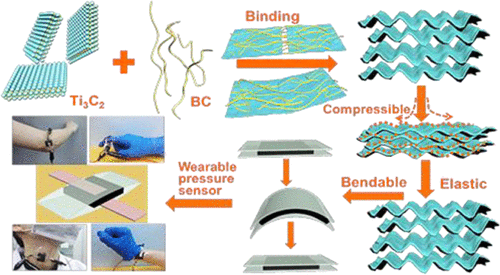当前位置:
X-MOL 学术
›
Chem. Mater.
›
论文详情
Our official English website, www.x-mol.net, welcomes your
feedback! (Note: you will need to create a separate account there.)
Compressible, Elastic, and Pressure-Sensitive Carbon Aerogels Derived from 2D Titanium Carbide Nanosheets and Bacterial Cellulose for Wearable Sensors
Chemistry of Materials ( IF 7.2 ) Pub Date : 2019-04-16 00:00:00 , DOI: 10.1021/acs.chemmater.9b00259
Zehong Chen 1 , Yijie Hu 1 , Hao Zhuo 1 , Linxiang Liu 1 , Shuangshuang Jing 1 , Linxin Zhong 1 , Xinwen Peng 1 , Run-cang Sun 2
Chemistry of Materials ( IF 7.2 ) Pub Date : 2019-04-16 00:00:00 , DOI: 10.1021/acs.chemmater.9b00259
Zehong Chen 1 , Yijie Hu 1 , Hao Zhuo 1 , Linxiang Liu 1 , Shuangshuang Jing 1 , Linxin Zhong 1 , Xinwen Peng 1 , Run-cang Sun 2
Affiliation

|
Compressible and elastic carbon aerogels (CECAs) hold great promise for applications in wearable electronics and electronic skins. MXenes, as new two-dimensional materials with extraordinary properties, are promising materials for piezoresistive sensors. However, the lack of sufficient interaction among MXene nanosheets makes it difficult to employ them to fabricate CECAs. Herein, a lightweight CECA is fabricated by using bacterial cellulose fiber as a nanobinder to connect MXene (Ti3C2) nanosheets into continuous and wave-shaped lamellae. The lamellae are highly flexible and elastic, and the oriented alignment of these lamellae results in a CECA with super compressibility and elasticity. Its ultrahigh structural stability can withstand an extremely high strain of 99% for more than 100 cycles and long-term compression at 50% strain for at least 100 000 cycles. Furthermore, it has a high sensitivity that demonstrates not only an ultrahigh linearity but also a broad working pressure range (0–10 kPa). In particular, the CECA has a high linear sensitivity in almost the entire workable strain range (0–95%). In addition, it has very low detection limits for tiny strain and pressure. These features enable the CECA-based sensor to be a flexible wearable device to monitor both subtle and large biosignals of the human body.
中文翻译:

源自2D碳化钛纳米片和可穿戴传感器的细菌纤维素的可压缩,弹性和压敏碳气凝胶。
可压缩弹性碳气凝胶(CECA)在可穿戴电子产品和电子皮肤中的应用前景广阔。MXenes作为具有特殊性能的新型二维材料,是用于压阻传感器的有前途的材料。但是,MXene纳米片之间缺乏足够的相互作用,使得难以使用它们来制造CECA。在此,通过使用细菌纤维素纤维作为纳米粘合剂连接MXene(Ti 3 C 2纳米片成连续的和波浪状的薄片。薄片是高度柔性和弹性的,并且这些薄片的定向排列导致CECA具有超压缩性和弹性。其超高的结构稳定性可在超过100个循环中承受99%的极高应变,并在至少100000个循环中以50%应变承受长期压缩。此外,它具有很高的灵敏度,不仅显示出超高的线性度,而且还显示了宽广的工作压力范围(0-10 kPa)。特别是,CECA在几乎整个工作应变范围内(0–95%)都具有很高的线性灵敏度。此外,它对于微小的应变和压力具有非常低的检测极限。这些功能使基于CECA的传感器成为灵活的可穿戴设备,可以监视人体的细微和大生物信号。
更新日期:2019-04-16
中文翻译:

源自2D碳化钛纳米片和可穿戴传感器的细菌纤维素的可压缩,弹性和压敏碳气凝胶。
可压缩弹性碳气凝胶(CECA)在可穿戴电子产品和电子皮肤中的应用前景广阔。MXenes作为具有特殊性能的新型二维材料,是用于压阻传感器的有前途的材料。但是,MXene纳米片之间缺乏足够的相互作用,使得难以使用它们来制造CECA。在此,通过使用细菌纤维素纤维作为纳米粘合剂连接MXene(Ti 3 C 2纳米片成连续的和波浪状的薄片。薄片是高度柔性和弹性的,并且这些薄片的定向排列导致CECA具有超压缩性和弹性。其超高的结构稳定性可在超过100个循环中承受99%的极高应变,并在至少100000个循环中以50%应变承受长期压缩。此外,它具有很高的灵敏度,不仅显示出超高的线性度,而且还显示了宽广的工作压力范围(0-10 kPa)。特别是,CECA在几乎整个工作应变范围内(0–95%)都具有很高的线性灵敏度。此外,它对于微小的应变和压力具有非常低的检测极限。这些功能使基于CECA的传感器成为灵活的可穿戴设备,可以监视人体的细微和大生物信号。

































 京公网安备 11010802027423号
京公网安备 11010802027423号